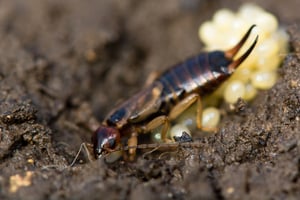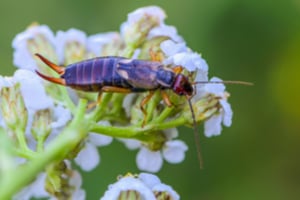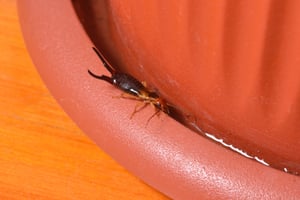Why do earwigs return in summer?
 Earwigs seem so active in late spring and early summer because of their unusual lifestyle. Like many insects, earwigs begin mating in the fall, in anticipation of winter. Unlike most insects, however, they don’t actually lay their eggs shortly after mating. Instead, male and female mates live together through the winter in a specially constructed underground nest. The female waits to lay her eggs until springtime--after kicking the male earwig out of the nest!
Earwig mothers lay eggs in batches of thirty to fifty. These eggs hatch after only about a week. Earwig mothers spend early spring guarding their eggs and young offspring. Earwig nymphs spend spring maturing and emerge near full adulthood in late May or early June. If you see a lot of earwigs in your yard, it might be because a nest hatched nearby. Earwigs remain active through fall, when they mate, build their overwintering nests, and repeat the cycle again.
Earwigs seem so active in late spring and early summer because of their unusual lifestyle. Like many insects, earwigs begin mating in the fall, in anticipation of winter. Unlike most insects, however, they don’t actually lay their eggs shortly after mating. Instead, male and female mates live together through the winter in a specially constructed underground nest. The female waits to lay her eggs until springtime--after kicking the male earwig out of the nest!
Earwig mothers lay eggs in batches of thirty to fifty. These eggs hatch after only about a week. Earwig mothers spend early spring guarding their eggs and young offspring. Earwig nymphs spend spring maturing and emerge near full adulthood in late May or early June. If you see a lot of earwigs in your yard, it might be because a nest hatched nearby. Earwigs remain active through fall, when they mate, build their overwintering nests, and repeat the cycle again.
What do earwigs want?
 Earwigs are attracted to dark, moist environments where they can find food. As nocturnal insects, they spend most of the day hunkered down in dark, secluded places. Earwigs prefer their hiding places to be moist, so they don’t dry out while they’re inactive. Usually, they find hiding places beneath something else. You might encounter them beneath decaying bark or logs, under boards or rocks, in loose dirt, or in cracks and crevices.
At night, earwigs leave their hiding places to forage for food. The omnivore primarily feeds on decaying organic matter such as dying or damaged plants and insect carcasses. Lacking a consistent source of decaying matter, earwigs may feed on healthy nearby plant life or even human food. The pest has been known to feed on the root systems, stems, leaves, fruits, and bulbs of common garden plants. Luckily, earwigs can’t inflict very much damage to garden plants.
Earwigs are attracted to dark, moist environments where they can find food. As nocturnal insects, they spend most of the day hunkered down in dark, secluded places. Earwigs prefer their hiding places to be moist, so they don’t dry out while they’re inactive. Usually, they find hiding places beneath something else. You might encounter them beneath decaying bark or logs, under boards or rocks, in loose dirt, or in cracks and crevices.
At night, earwigs leave their hiding places to forage for food. The omnivore primarily feeds on decaying organic matter such as dying or damaged plants and insect carcasses. Lacking a consistent source of decaying matter, earwigs may feed on healthy nearby plant life or even human food. The pest has been known to feed on the root systems, stems, leaves, fruits, and bulbs of common garden plants. Luckily, earwigs can’t inflict very much damage to garden plants.
Why are earwigs around my home?
 Earwigs want darkness, shelter, moisture, and food. If the insects have infested your home or garden, it’s because they’re finding these things somewhere. Earwigs are particularly attracted to environments that check off multiple boxes on their “wishlist” at once. Dark, wet, moldy environments are ideal, for instance, because earwigs can feed on the mold without leaving their hiding places. Wet mulch is easy for earwigs to crawl through and lets them access plant life easily.
The more hiding places the pest has, the more comfortable they’ll feel foraging around your home. Tall grass, lawn debris, overgrown shrubs, woodpiles, and leaves make ideal shelters. Most of all, earwigs love decaying plant life. Overripe fruit or dying plants serve as excellent food sources. They’ll also feed on arthropods that come to eat the material, making it even more attractive. Earwigs may feed on other small pests near your home, too. Spiders, aphids, springtails, and scale insects may all attract earwigs.
Earwigs want darkness, shelter, moisture, and food. If the insects have infested your home or garden, it’s because they’re finding these things somewhere. Earwigs are particularly attracted to environments that check off multiple boxes on their “wishlist” at once. Dark, wet, moldy environments are ideal, for instance, because earwigs can feed on the mold without leaving their hiding places. Wet mulch is easy for earwigs to crawl through and lets them access plant life easily.
The more hiding places the pest has, the more comfortable they’ll feel foraging around your home. Tall grass, lawn debris, overgrown shrubs, woodpiles, and leaves make ideal shelters. Most of all, earwigs love decaying plant life. Overripe fruit or dying plants serve as excellent food sources. They’ll also feed on arthropods that come to eat the material, making it even more attractive. Earwigs may feed on other small pests near your home, too. Spiders, aphids, springtails, and scale insects may all attract earwigs.
How can I keep earwigs away?
 Earwigs come to you because you have things they want. The way to drive them off is by making sure they can’t get those things. First and foremost, you should deprive earwigs of easy access to moisture. If an earwig can’t stay hydrated around your home, they’ll have to go elsewhere or they’ll dry out and die. Outside, unclog your gutters and downspouts and make sure they’re draining properly. Inside, find and fix drafts and plumbing leaks, and dehumidify vulnerable areas.
After you deal with moisture considerations, your next step should be depriving them of shelter. Remove lawn debris like firewood, piles of leaves, and fallen twigs. Trim down your grass, bushes, and ornamental plants. Generally, keep the approach to your home as clear as possible. Inside, clear out the clutter from dark areas like your basement. Keep boxes and bags off the floor whenever possible. Last but not least, look for and patch up the cracks and crevices earwigs use to enter your home.
Earwigs are ultimately harmless nuisance pests. They can’t hurt you, they seldom seriously damage plant life, and they don’t transmit diseases. The only reason to keep them from infesting your home or garden is so that you don’t keep running across them. That’s reason enough!
If you’re having earwig problems--or any other kind of pest problem--this summer, give Plunkett’s a call. We’ve been wiping out earwigs for over 100 summers now, and we’ve picked up quite a few tricks along the way. We’ll help make sure your summer stays pest-free.
Earwigs come to you because you have things they want. The way to drive them off is by making sure they can’t get those things. First and foremost, you should deprive earwigs of easy access to moisture. If an earwig can’t stay hydrated around your home, they’ll have to go elsewhere or they’ll dry out and die. Outside, unclog your gutters and downspouts and make sure they’re draining properly. Inside, find and fix drafts and plumbing leaks, and dehumidify vulnerable areas.
After you deal with moisture considerations, your next step should be depriving them of shelter. Remove lawn debris like firewood, piles of leaves, and fallen twigs. Trim down your grass, bushes, and ornamental plants. Generally, keep the approach to your home as clear as possible. Inside, clear out the clutter from dark areas like your basement. Keep boxes and bags off the floor whenever possible. Last but not least, look for and patch up the cracks and crevices earwigs use to enter your home.
Earwigs are ultimately harmless nuisance pests. They can’t hurt you, they seldom seriously damage plant life, and they don’t transmit diseases. The only reason to keep them from infesting your home or garden is so that you don’t keep running across them. That’s reason enough!
If you’re having earwig problems--or any other kind of pest problem--this summer, give Plunkett’s a call. We’ve been wiping out earwigs for over 100 summers now, and we’ve picked up quite a few tricks along the way. We’ll help make sure your summer stays pest-free.






